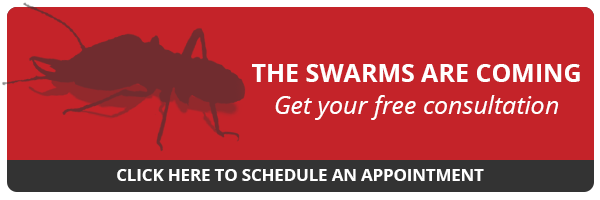Spring time brings lots of changes, the weather starts getting warmer, the grass gets greener and of course, the bugs start coming out of hiding. While flies and mosquitos may be a nuisance, no bug is more concerning to homeowners than the termite season. If you’ve lived in the south for any period of time, it’s very likely that you’ve encountered a swarm of termites during the spring and early summer.
Formosan Termite Season
Termite season, for most homeowners, means the likelihood of encountering a swarm of termites increase, bringing with it the increased chance for an infestation as the swarms find a location to build their nest. In the south, the season brings Formosan termites, a subterranean termite that causes major problems for homeowners.
The Formosan termite swarms during spring and early summer, and can be found swarming in the early evening hours and at night. They tend to swarm near well-lit areas such as flood lighting on a home. They are also attracted to lighting inside of a home, and will swarm near a light source, doing what they can to gain access to the interior of the home.
Swarming termites have gotten a lot of attention in recent years, and while the swarms may garner more attention, it’s what the swarms lead to that homeowners need to be concerned with. The swarms do not directly damage the home, but instead provide an opportunity to locate and build a new colony. Once the swarm has found a location, they begin to breed, creating infinitely more workers that will turn a home into a termite construction site in a matter of months.
Termite Swarming Season
For most of the south, termite swarming season begins in early February and lasts until early August. During this time, you can expect to run into swarms during evening hours in well-lit areas. While swarming season is underway, it is important for homeowners to keep an eye out for signs of an infestation, and to take action before it’s too late. In general, there are three signs to look for to identify the presence of termites:
- Termites swarming in nearby areas or close to the home
- Mud tubes
- Damaged wood around the property or on the house
Should any of these signs present themselves around your home, you should contact a pest control service immediately for an inspection to determine whether or not the property has an infestation.
Become Informed, Protect Your Home
The most important factor for homeowners during termite season is getting informed and preparing your property. At Arrow Termite & Pest Control we’re dedicated to educating our customers and area residents about the dangers of termite infestations, what to look for and how to protect your property.
Should you feel that your property may have a termite problem, contact Arrow Termite & Pest Control immediately to have your home professionally inspected and treated.

